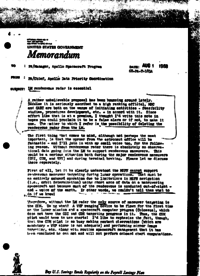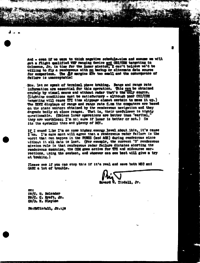PA/Manager, Apollo Spacecraft ProgramAUG 1 196868-PA-T-183APA/Chief, Apollo Data Priority CoordinationLM rendezvous radar is essential
A rather unbelievable proposal has been bouncing around lately. Because it is seriously ascribed to a high ranking official, MSC and GAEC are both on the verge of initiating activities – feasibility studies, procedures development, etc. – in accord with it. Since effort like that it at a premium, I thought I'd write this note in hopes you could proclaim it to be a false alarm or if not, to make it one. The matter to which I refer is the possibility of deleting the rendezvous radar from the LM.
The first thing that comes to mind, although not perhaps the most important, is that the uproar from the astronaut office will be fantastic – and I'll join in with my small voice too, for the follow- ing reason. Without rendezvous radar there is absolutely no observa- tional data going into the LM to support rendezvous maneuvers. This would be a serious situation both during the major rendezvous maneuvers (CDI, CDH, and TPI) and during terminal braking. Please let me discuss these separately.
First of all, let it be clearly understood the MSFN cannot support rendezvous maneuver targeting during lunar operations. That must be an entirely onboard operation due to limitations in MSFN navigation (i.e., orbit determination) using short arcs of data on a maneuvering spacecraft and because much of the rendezvous is conducted out-of-sight – and – voice of the earth. In other words, we couldn't tell them what to do if we knew!
Therefore, without the LM radar the only source of maneuver targeting is the CSM. Using what? A VHF ranging device to be flown for the first time on the lunar mission and a spacecraft computer program (Colossus), which does not have the CSI and CDH targeting programs in it. This, the CSM pilot would have to use charts! I'd like to emphasize the fact, though, that the CSM pilot is so busy making sextant observations (which are mandatory – VHF alone is not adequate) and performing mirror image targeting, etc. along with routine spacecraft management that it has been concluded he can not and will not perform onboard chart computations.
And – even if we were to think negative schedule-wise and assume we will get a flight qualified VHF ranging device and CSI/CDH targeting in Colossus, Jr. in time for the lunar mission, I can't believe we'd be willing to fly a rendezvous with no backup or alternate data source for comparison. The ΔV margins are too small and the consequence of failure is unacceptable!
Now, let me speak of terminal phase braking. Range and range rate information are essential for this operation. This can be obtained crudely by visual means and without radar that's the only source. (Lighting conditions must be satisfactory – although poor CSI/CDH targeting will cause TPI time slippage almost certain to mess it up.) The DSKY displays of range and range rate from the computers are based on the state vectors obtained by the rendezvous navigation and they degrade badly at close ranges. That is, their usefulness if highly questionable. (Unless lunar operations are better than “earthal,” they are worthless; I'm not sure if lunar is better or not.) So its the eyeballs then and plenty of RCS.
If I sound like I'm on some higher energy level about this, it's cause I am. I'm sure most will agree that a rendezvous radar failure is the worst that can happen in the PGNCS (and AGS) during rendezvous since without it all data is lost. (For example, the current “D” rendezvous mission rule is that rendezvous radar failure dictates aborting the rendezvous exercise, the CSM goes active for TPI and midcourse cor- rections, using the sextant, and whoever can see best will give a try at braking.)
Please see if you can stop this if it's real and save both MSC and GAEC a lof of trouble.
- Nov 24, 1969 – Rover Navigation (3.7σ)


